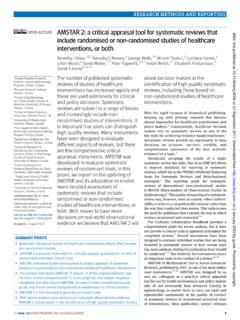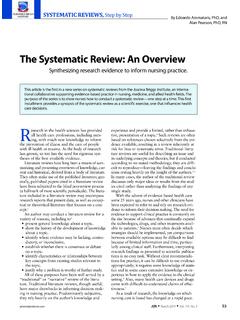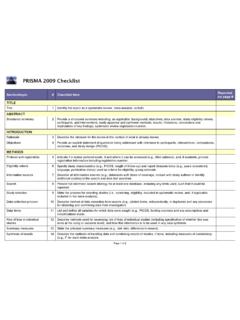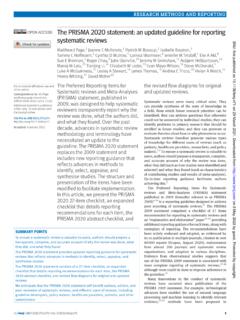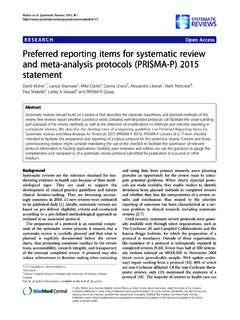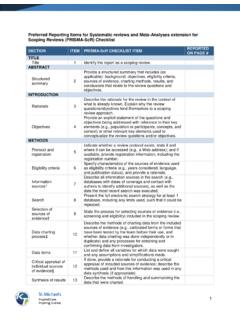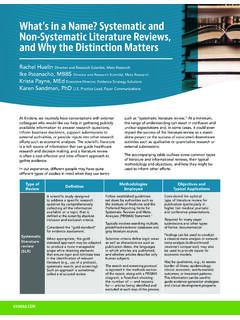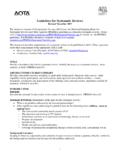Transcription of The PRISMA 2020 statement: an updated guideline for ...
1 PRISMA 2020 statement. MetaArXiv preprint (September 2020) 1 The PRISMA 2020 statement: an updated guideline for reporting systematic reviews Matthew J Page, senior research fellow1,*, Joanne E McKenzie, associate professor1, , Patrick M Bossuyt, professor2, Isabelle Boutron, professor3, Tammy C Hoffmann, professor4, Cynthia D Mulrow, professor5, Larissa Shamseer, doctoral student6, Jennifer M Tetzlaff, research product specialist7, Elie A Akl, professor8, Sue E Brennan, senior research fellow1, Roger Chou, professor9, Julie Glanville, associate director10, Jeremy M Grimshaw, professor11, Asbj rn Hr bjartsson, professor12, Manoj M Lalu, associate scientist and assistant professor13, Tianjing Li, associate professor14, Elizabeth W Loder, professor15, Evan Mayo-Wilson, associate professor16, Steve McDonald, senior research fellow1, Luke A McGuinness, research associate17, Lesley A Stewart, professor and director18, James Thomas, professor19, Andrea C Tricco, scientist and associate professor20, Vivian A Welch.
2 Associate professor21, Penny Whiting, associate professor17, David Moher, director and professor22, 1. School of Public Health and Preventive Medicine, Monash University, Melbourne, Australia 2. Department of Clinical Epidemiology, Biostatistics and Bioinformatics, Amsterdam University Medical Centres, University of Amsterdam, Amsterdam, Netherlands 3. Universit de Paris, Centre of Epidemiology and Statistics (CRESS), Inserm, F 75004 Paris, France 4. Institute for Evidence-Based Healthcare, Faculty of Health Sciences and Medicine, Bond University, Gold Coast, Australia 5. University of Texas Health Science Center at San Antonio, San Antonio, Texas, United States; Annals of Internal Medicine 6. School of Epidemiology and Public Health, Faculty of Medicine, University of Ottawa, Ottawa, Canada 7. Evidence Partners, Ottawa, Canada 8. Clinical Research Institute, American University of Beirut, Beirut, Lebanon; Department of Health Research Methods, Evidence, and Impact, McMaster University, Hamilton, Ontario, Canada 9.
3 Department of Medical Informatics and Clinical Epidemiology, Oregon Health & Science University, Portland, Oregon, United States 10. York Health Economics Consortium (YHEC Ltd), University of York, York, UK 11. Clinical Epidemiology Program, Ottawa Hospital Research Institute, Ottawa, Canada; School of Epidemiology and Public Health, University of Ottawa, Ottawa, Canada; Department of Medicine, University of Ottawa, Ottawa, Canada PRISMA 2020 statement. MetaArXiv preprint (September 2020) 2 12. Centre for Evidence-Based Medicine Odense, Odense University Hospital, Odense, Denmark; Department of Clinical Research, University of Southern Denmark, Odense, Denmark; Open Patient data Explorative Network, Odense University Hospital, Odense, Denmark 13. Department of Anesthesiology and Pain Medicine, The Ottawa Hospital, Ottawa, Canada; Clinical Epidemiology Program, Blueprint Translational Research Group, Ottawa Hospital Research Institute, Ottawa, Canada; Regenerative Medicine Program, Ottawa Hospital Research Institute, Ottawa, Canada 14.
4 Department of Ophthalmology, School of Medicine, University of Colorado Denver, Denver, Colorado, United States; Department of Epidemiology, Johns Hopkins Bloomberg School of Public Health, Baltimore, Maryland, United States 15. Division of Headache, Department of Neurology, Brigham and Women's Hospital, Harvard Medical School, Boston, Massachusetts, United States; Head of Research, The BMJ, London, UK 16. Department of Epidemiology and Biostatistics, Indiana University School of Public Health-Bloomington, Bloomington, Indiana, United States 17. Population Health Sciences, Bristol Medical School, University of Bristol, Bristol, UK 18. Centre for Reviews and Dissemination, University of York, York, UK 19. EPPI-Centre, UCL Social Research Institute, University College London, London, UK 20. Li Ka Shing Knowledge Institute of St. Michael's Hospital, Unity Health Toronto, Toronto, Canada; Epidemiology Division of the Dalla Lana School of Public Health and the Institute of Health Management, Policy, and Evaluation, University of Toronto, Toronto, Canada; Queen's Collaboration for Health Care Quality Joanna Briggs Institute Centre of Excellence, Queen's University, Kingston, Canada 21.
5 Methods Centre, Bruy re Research Institute, Ottawa, Ontario, Canada; School of Epidemiology and Public Health, Faculty of Medicine, University of Ottawa, Ottawa, Canada 22. Centre for Journalology, Clinical Epidemiology Program, Ottawa Hospital Research Institute, Ottawa, Canada; School of Epidemiology and Public Health, Faculty of Medicine, University of Ottawa, Ottawa, Canada *Correspondence to: Dr. Matthew Page, School of Public Health and Preventive Medicine, Monash University, 553 St Kilda Road, Melbourne, Victoria, 3004, Australia. Telephone: +61 9903 0248. Email address: JEM and DM are joint senior authors. PRISMA 2020 statement. MetaArXiv preprint (September 2020) 3 Dedication: We dedicate this paper to the late Douglas G Altman and Alessandro Liberati, whose contributions were fundamental to the development and implementation of the original PRISMA statement. PRISMA 2020 statement. MetaArXiv preprint (September 2020) 4 Abstract Background: The preferred reporting Items for systematic reviews and Meta-Analyses ( PRISMA ) Statement, published in 2009, was designed to help systematic reviewers transparently report why the review was done, what the authors did and what they found.
6 Over the last decade, there have been many advances in systematic review methodology and terminology, which have necessitated an update to the guideline . Objectives: To develop the PRISMA 2020 statement for reporting systematic reviews. Methods: We reviewed 60 documents with reporting guidance for systematic reviews to generate suggested modifications to the PRISMA 2009 statement. We sought feedback on the suggested modifications through an online survey of 110 systematic review methodologists and journal editors. The results of the review and survey were discussed at a 21-member in-person meeting. Following the meeting, drafts of the PRISMA 2020 checklist, abstract checklist, explanation and elaboration and flow diagram were generated and refined iteratively based on feedback from co-authors and a convenience sample of 15 systematic reviewers. Results: In this statement paper, we present the PRISMA 2020 27-item checklist, an expanded checklist that details reporting recommendations for each item, the PRISMA 2020 abstract checklist, and the revised flow diagrams for original and updated reviews.
7 The checklist includes new reporting guidance that reflects advances in methods to identify, select, appraise and synthesise studies. The structure and presentation of the items have been modified to facilitate implementation. The PRISMA 2020 statement replaces the 2009 statement. Conclusions: The PRISMA 2020 statement is intended to facilitate transparent, complete and accurate reporting of systematic reviews. Improved reporting should benefit users of reviews, including guideline developers, policy makers, health care providers, patients and other stakeholders. In order to achieve this, we encourage authors, editors and peer-reviewers to adopt the guideline . PRISMA 2020 statement. MetaArXiv preprint (September 2020) 5 INTRODUCTION systematic reviews serve many critical roles. They can provide syntheses of the state of knowledge in a field, from which future research priorities can be identified; they can address questions that otherwise could not be answered by individual studies; they can identify problems in primary research that should be rectified in future studies; and they can generate or evaluate theories about how or why phenomena occur.
8 systematic reviews therefore generate various types of knowledge for different users of reviews ( patients, health care providers, researchers, and policy makers) (1, 2). To ensure a systematic review is valuable to users, authors should prepare a transparent, complete and accurate account of why the review was done, what they did ( how studies were identified and selected) and what they found ( characteristics of contributing studies and results of meta-analyses). Up-to-date reporting guidance facilitates authors achieving this (3). The preferred reporting Items for systematic reviews and Meta-Analyses ( PRISMA ) statement published in 2009 (hereafter referred to as PRISMA 2009) (4-7) is a reporting guideline designed to address poor reporting of systematic reviews (8). The PRISMA 2009 statement comprised a checklist of 27 items recommended for reporting in systematic reviews and an explanation and elaboration paper (9-12) providing additional reporting guidance for each item, along with exemplars of reporting .
9 The recommendations have been widely endorsed and adopted, as evidenced by its co-publication in multiple journals, citation in over 60,000 reports (Scopus, August 2020), endorsement from almost 200 journals and systematic review organisations, and adoption in various disciplines. Evidence from observational studies suggests that use of the PRISMA 2009 statement is associated with more complete reporting of systematic reviews (13-16), although more could be done to improve adherence to the guideline (17). Many innovations in the conduct of systematic reviews have occurred since publication of the PRISMA 2009 statement. For example, technological advances have enabled the use of natural language processing and machine learning to identify relevant evidence (18-20); methods have been proposed to synthesise and present findings when meta-analysis is not possible or appropriate (21-23); and new methods have been developed to assess the risk of bias in results of included studies (24, 25).
10 Evidence on sources of bias in systematic reviews has accrued, culminating in the development of new tools to appraise the conduct of systematic reviews (26, 27). Terminology used to describe particular review processes has also evolved, as in the shift from assessing quality to assessing certainty in the body of evidence (28). In addition, the publishing landscape has transformed, with multiple avenues now available for registering and disseminating systematic review protocols (29, 30), disseminating reports PRISMA 2020 statement. MetaArXiv preprint (September 2020) 6 of systematic reviews, and sharing data and materials, such as preprint servers and publicly accessible repositories. To capture these advances in the reporting of systematic reviews necessitated an update to the PRISMA 2009 statement. DEVELOPMENT OF PRISMA 2020 Several steps were taken to develop PRISMA 2020 (a complete description of the methods used is available elsewhere (31)).

